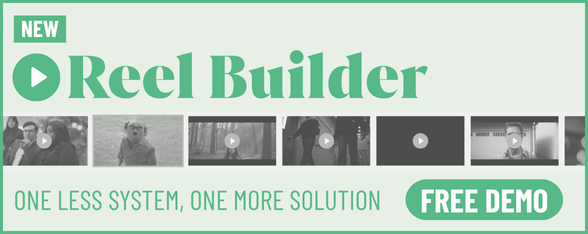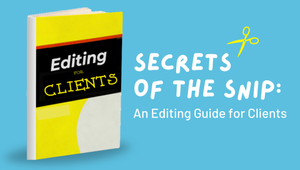
The Rhythm of Editing with Chinwe Chong

Chinwe Chong is a video editor based in New York City. The global perspective she brings to storytelling is shaped by a rich multicultural heritage.
A first-generation American of Jamaican-Chinese and British descent, she grew up between Boulder, Paris, and Brooklyn, and spent her early years dancing. Chong approaches editing with a deep appreciation for visual composition achieved through rhythm and movement.
Coming from a family of artists, she values creativity as both legacy and language—using the edit as a canvas to craft compelling, poetic narratives.
LBB> The first cut is the deepest: how do you like to start an editing project?
Chinwe> Real talk? With a healthy dose of panic. But I like to think it’s productive panic.
I tend to surrender to my curiosity and excitement, to dive in and scrub through all the footage to get a sense of the palette and compositions. I take note of the images that catch my eye and observe where my mind goes in those moments - my personal associations with the footage and sensory reactions to it – sometimes I’ll have a memory that elicits a sound and so forth.
From there, I may put on some music and start screening, letting my intuition guide my selects. I’ve learned to embrace and trust that chaos because, inevitably, a solid cut emerges from my voice.
LBB> Non-editors often think of editing just in technical terms but it’s integral to the emotion and mood of a film. How did you develop that side of your craft?
Chinwe> I don't know if it's something I developed as much as something I listened to. Editing is instinctual and honest. I find it to be quite intimate – I frequently sort of fall in love with the subject.
It’s like the delicious torture of a crush. You notice the little things, the things that make you feel more than you see.
You know when you want to linger and savour a moment, and you know when you want to GTFO. Challenging and countering those impulses can teach you a lot as well. There’s magic in the unexpected on all fronts. It all comes down to trusting the process.
LBB> How important is an understanding of story and the mechanics of story?
Chinwe> It’s important, of course, to understand story. But it shouldn’t be rigid. I think the human condition is ever-evolving and morphing. Taking those cues and allowing the story to shift and present itself to you is equally important.
As with any creative field, you need the process of discovery to achieve quality composition, meaning that if you are too literal or strictly linear, you risk missing out on the poetry, which is what differentiates a good piece from a beautiful one.
There is a natural and continued evolution of ‘the story’ in the edit room. You might have all the pieces, but it’s only when they start moving together that the real narrative or composition emerges. The same goes for ‘negative space,’ the stuff between the lines, the off-kilter.
What was on the page shifts, sometimes subtly, sometimes drastically, and it’s in that space where it stops being an assembly of clips and becomes something real.
So, yes, knowing story mechanics helps, but being open to discovering story in the edit is just as crucial.
LBB> Rhythm and a sense of musicality seem to be intrinsic to good editing – how do you think about the rhythm side of editing, how do you feel out the beats of a scene or a spot? And do you like to cut to music?
Chinwe> Rhythm is intrinsic to the process. It’s in the breath between lines, the silence before a reaction, the way a shot lands.
Sometimes, the edit is dance—you feel when a movement (or a cut) lands just right. Cutting to music can be fun, but I love playing with contrast, finding unexpected syncopations that elevate a scene. Tension building up to a release or vice versa.
The rhythm is in the edit as much as the actual music - it’s a balance between indulging in a long shot and the staccato interruption of moments. Make the viewer feel something even if they can’t place it.
LBB> Tell us about a recent editing project that involved some interesting creative challenges.
Chinwe> I never kiss and tell… But I will say that challenges are inevitable and they arise in many shapes and parts of the process. It’s really about whether you can find a way to use them to your advantage. Use the difficulties as a prompt, an exercise. Challenges force you out of your comfort zone and ultimately lead to growth. Easier said now than in the moment, no doubt.
LBB> In the US we know that editors are much more heavily involved across the post production process than in Europe - what’s your favourite part of that side of the job?
Chinwe> Keeping the creative collaboration going past the edit (after working with the director and the agency). The industry is brimming with talented and creative people, and it’s a treat to get to know as many of them as possible and to admire and absorb their individual craft.
As editors, we spend the most time with the footage in the assembly line, establishing preliminary creative choices - sound effects, music edits, temp colour tweaks, mattes and masks - the list goes on, so, naturally, it becomes your baby too, so it’s nice to see it through and aid in upholding or finessing the integrity of those creative choices.
LBB> What’s harder to cut around – too much material or not enough?
Chinwe> Ha! Each stitch has its respective chaos and can make you question your life choices, but ultimately, you get there. When you don’t have enough, you’re forced to find a way to create what you need, and that can be a beautiful exercise when you muscle through it. When you have too much, you thank the stars for the best bits and go with the flow in sorting the rest. Widdle widdle widdle.
LBB> Which commercial projects are you proudest of and why?
Chinwe> I’ve loved working with the Spike DDB team on Cadillac over the last few years. Thanks to their vision and curiosity, every project has been different with a fresh creative approach all while keeping it real, with a commitment to the people and culture.
From Hip Hop to Motown, Afrofuturism to Hispanic or Asian heritage, they don’t play when it comes to representing and honouring the richness and diversity of their consumers. I’ve been a Hip Hop head all my life, so when they tapped Big Boi for the release of the Electric Escalade IQ, I geeked super hard.
It was a dream come true to edit him waxing poetic about the virtues of the new whip! Whew, it made so much sense.
LBB> There are so many different platforms for film content now, and even in advertising something can last anything from a few seconds to a couple of hours. As an editor, are you seeing a change in the kind of projects you’re getting from brands and agencies?
Chinwe> Absolutely. We’re in the age of the six second masterpiece and the longform branded doc, and it’s wild. Attention spans are shrinking, but storytelling? That’s ever-evolving.
There’s this push for everything to be tighter, punchier, but at the same time, we’re also seeing brands lean into long-form, giving editors more space to breathe.
Brands want multi-platform storytelling now—something that works as a 15-second TikTok but can also hold up as a two-minute spot. It means rethinking structure, pacing, and impact. It keeps things exciting because no two projects are the same.
LBB> Who are your editing heroes and why? What films or spots epitomise good editing for you?
Chinwe> I didn’t come from a film background, so I’ve always just gravitated toward what I love. I know that’s a vague answer, but it’s an honest one.
I’m blessed to be surrounded by supremely talented and supportive editors, many of whom mentored me at Consulate. I know something is good when I’m moved, and that happens on the daily when poking my head in the suites around the office.
As for a specific piece - one music video that struck me early on in my career (when I was in client services and hadn’t even touched the edit suites) was the ‘Get Free’ music video by So Me for Major Lazer. It’s clean, direct, beautiful, and had me in my feelings.
LBB> How does editing in the commercial world differ from the film world and TV world?
Chinwe> Speed. Schedules are tight in advertising, and it’s often a sprint from the get-go. Whereas in film, it’s an adagio at first. That said, both ramp up towards the finish line. It’s also a different state of mind, different muscle editing a film versus editing commercials; it can be difficult to dance between the two.
LBB> Have you noticed any trends or changes in commercial editing over recent years?
Chinwe> Most definitely. In my short tenure, I’ve noticed certain fads that come and go. We’re in a moment of what I call the anti-edit. So much of what I see right now is about the tricky transitions — one shot pushing through or whipping to the next. Different from match cuts, it’s pretty reliant on VFX and can be dope, but it tows the line of gimmicky when used without restraint. It’s a reflection of the times: we’ve got shorter attention spans. We are hungry for things to zoom, zip, and flash.















